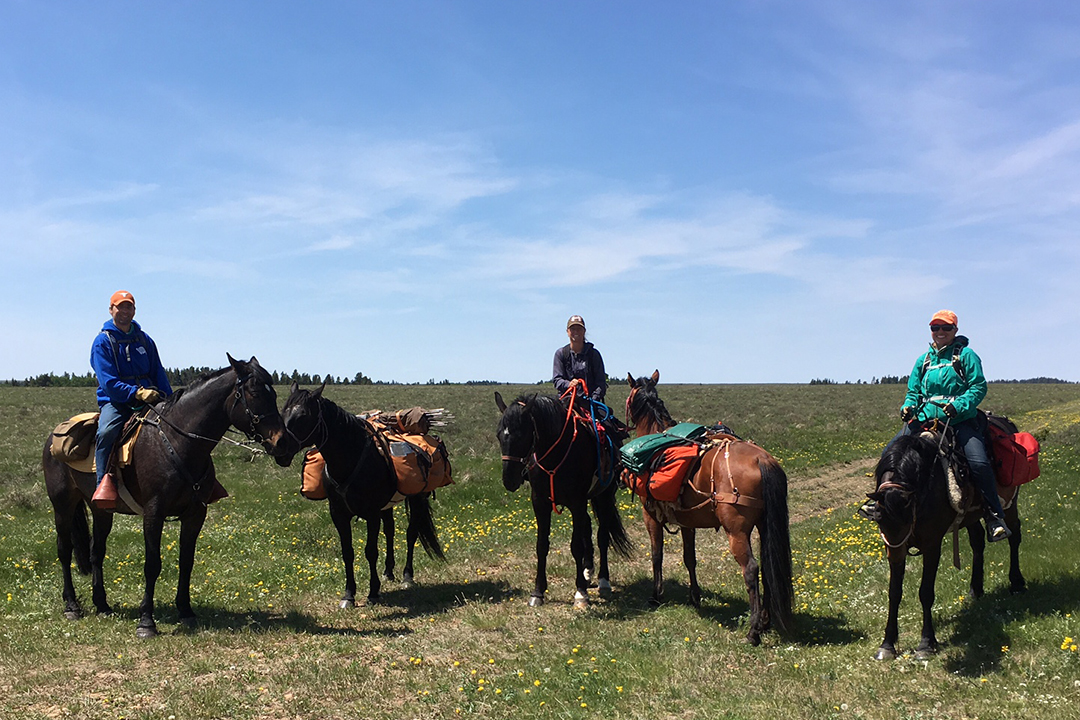
Long ride fulfils lasting dream
They call it “The Ride” – a horseback adventure across Western Canada that began with David Nahachewsky’s bucket list, written after his run-in with cancer in 2001.
By Kyrsten StringerWhen his daughters, Stacey and Teresa, found out what their father planned to do, there was no way they were going to let him go alone. Their adventure took 10 years to research and organize, but it finally began this spring in Pierson, Man., on Apr. 9, 2017.
Stacey, a 2014 graduate of the Western College of Veterinary Medicine (WCVM), says that it was always more a matter of when and never a matter of if “The Ride” would happen. This spring, she took time off from practising at Poplar Grove Veterinary Services in Innisfail, Alta., to join her father and her sister on their journey through the highs and lows of the Canadian West.
Teresa left behind her job as a registered veterinary technologist in Prince Albert, Sask., while David recently retired from his firefighting job in Saskatoon.
The Nahachewskys started their journey in Manitoba with the goal of hitting the West Coast and becoming members of the Long Riders Guild — an association for equestrian explorers who have travelled 1,000 continuous miles (1,609 kilometres) in a single journey.
“Through contacting the Long Riders Guild, we discovered that we could be Long Riders on this trip,” says Teresa. “It’s a personal achievement — just the different challenges that you face on a trip like this. When you’re riding day in day out for months with your horse, you see things and you go through things that are way different.”
“Our route changes all of the time,” says David, and his words are applicable to every part of their journey. For part of their trip, the Nahachewskys pulled a wagon. But when the terrain got too hilly, they switched to packing their horses and riding horseback.
“We have totally changed our perspective of equestrian long riding — travel with horse,” says David. “We don’t worry about where we’re going or how far we have to go. We don’t think that way anymore. We think about, ‘Let’s wake up, let’s go have fun, let’s see what there is to see around the next corner.’ It’s totally changed the way we think.”
It’s what the Nahachewskys refer to as “horse time.” As Stacey explains, horses can’t be rushed. “They force you to relax and to take a deep breath and do things properly. They’re good for your mental health.”
Being a veterinarian on a months-long horseback tour has its advantages — it’s like having a mechanic along for a road trip. Before starting out, each of the six horses that the Nahachewskys planned to travel with were vaccinated, dewormed and had their teeth floated. All of the horses also underwent Coggins tests to ensure that they were negative for equine infectious anemia. Stacey, who is also certified in animal chiropractic care, performed adjustments on the horses before setting out. She’s been continuing the treatments throughout the trip.
“We keep the same horses all the time, and that means that we have to maintain their health, and they have to start with good health,” says David, adding that a horse with poor conformation will get sore and tire more quickly on the road.
“If it doesn’t have decent bone – very hard feet — you know, it probably won’t take the pounding of the road. And it has to be a good keeper.”
The Nahachewskys cover anywhere from 20 to 40 km a day. After the day’s ride is done, the Nahachewskys camp in fields and ditches. Or sometimes, strangers take them in.
“People will invite us into their homes and put up our horses. The generosity and the kindness of the people that we’ve met along the way is amazing,” says Stacey, adding that they rely on local residents for advice about where to ride.
“The biggest way that our route changed is through the mountains,” says Teresa. She explains that the Nahachewskys had initially planned to enter British Columbia through Waterton Lakes National Park, but a new friend who is familiar with the area warned them against it. “He said it’s too dangerous unless you know the area a lot better, and we’re all prairie people.”
Because of the constantly changing nature of their journey, the Nahachewskys aren’t sure how long their trip will take them or precisely where they will end up.
What started out as David’s bucket list dream has become a reality — a difficult and constantly changing journey, but one full of unexpected turns and beautiful scenery. It has tested their endurance, brought them closer as a family and shown them things that people don’t get to see when they travel in a car.
“You can go off the road — if you see a beautiful valley or coulee, you can go through that. The wildlife aren’t afraid of you,” says Stacey, who recalls watching an antelope teach her baby how to cross the road one morning.
“Travelling on horse[back], you have a permanent companion. You’re riding on him, so you know — when you’re sitting there for the fourth hour you can start talking to him. It’s very much a bonding experience.”
This article was originally published in the Fall 2017 issue of Horse Health Lines, the news publication for the Townsend Equine Health Research Fund. Click here to read the full magazine, or visit tehrf.ca.
